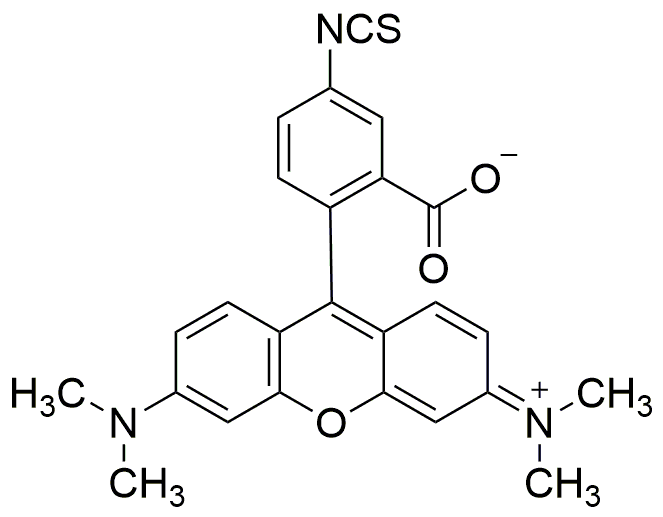Tetramethylrhodamine-5-isothiocyanate is widely utilized in research focused on:
- Fluorescent Labeling: This compound is commonly used to label proteins and antibodies in various biological assays, enhancing visualization under fluorescence microscopy.
- Cell Imaging: It serves as a vital tool in cell biology for tracking cellular processes, enabling researchers to study live cells and their interactions in real-time.
- Diagnostics: In medical research, it plays a role in developing diagnostic assays, particularly in detecting specific biomolecules associated with diseases.
- Environmental Monitoring: The compound is employed in environmental science to trace pollutants and study their effects on ecosystems, thanks to its high sensitivity and stability.
- Drug Development: It aids in the pharmaceutical industry by facilitating the study of drug interactions and mechanisms, providing insights that can lead to more effective therapies.
Informations générales
Propriétés
Sécurité et réglementation
Applications
Tetramethylrhodamine-5-isothiocyanate is widely utilized in research focused on:
- Fluorescent Labeling: This compound is commonly used to label proteins and antibodies in various biological assays, enhancing visualization under fluorescence microscopy.
- Cell Imaging: It serves as a vital tool in cell biology for tracking cellular processes, enabling researchers to study live cells and their interactions in real-time.
- Diagnostics: In medical research, it plays a role in developing diagnostic assays, particularly in detecting specific biomolecules associated with diseases.
- Environmental Monitoring: The compound is employed in environmental science to trace pollutants and study their effects on ecosystems, thanks to its high sensitivity and stability.
- Drug Development: It aids in the pharmaceutical industry by facilitating the study of drug interactions and mechanisms, providing insights that can lead to more effective therapies.
Documents
Fiches de données de sécurité (FDS)
La FDS fournit des informations de sécurité complètes sur la manipulation, le stockage et l’élimination du produit.
Spécifications du produit (PS)
Le PS fournit une description complète des propriétés du produit, notamment sa composition chimique, son état physique, sa pureté et les exigences de stockage. Il détaille également les plages de qualité acceptables et les applications prévues du produit.
Certificats d'analyse (COA)
Recherchez des certificats d'analyse (COA) en saisissant le numéro de lot du produit. Les numéros de lot et de lot se trouvent sur l'étiquette d'un produit, après les mots « Lot » ou « Lot de fabrication ».
Numéro de catalogue
Numéro de lot/série
Certificats d'origine (COO)
Ce certificat d'exploitation confirme le pays dans lequel le produit a été fabriqué, et détaille également les matériaux et composants utilisés et s'il est issu de sources naturelles, synthétiques ou autres sources spécifiques. Ce certificat peut être requis pour les douanes, le commerce et la conformité réglementaire.
Numéro de catalogue
Numéro de lot/série
Fiches de données de sécurité (FDS)
La FDS fournit des informations de sécurité complètes sur la manipulation, le stockage et l’élimination du produit.
DownloadSpécifications du produit (PS)
Le PS fournit une description complète des propriétés du produit, notamment sa composition chimique, son état physique, sa pureté et les exigences de stockage. Il détaille également les plages de qualité acceptables et les applications prévues du produit.
DownloadCertificats d'analyse (COA)
Recherchez des certificats d'analyse (COA) en saisissant le numéro de lot du produit. Les numéros de lot et de lot se trouvent sur l'étiquette d'un produit, après les mots « Lot » ou « Lot de fabrication ».
Numéro de catalogue
Numéro de lot/série
Certificats d'origine (COO)
Ce certificat d'exploitation confirme le pays dans lequel le produit a été fabriqué, et détaille également les matériaux et composants utilisés et s'il est issu de sources naturelles, synthétiques ou autres sources spécifiques. Ce certificat peut être requis pour les douanes, le commerce et la conformité réglementaire.


